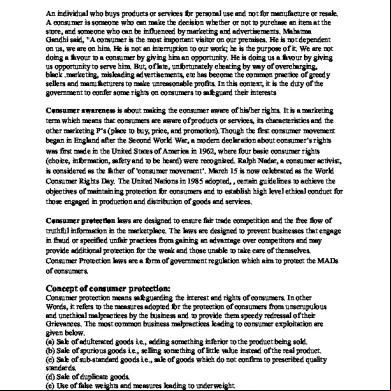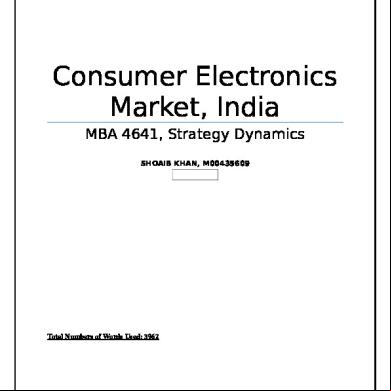Consumer Awareness In India c4t2o
This document was ed by and they confirmed that they have the permission to share it. If you are author or own the copyright of this book, please report to us by using this report form. Report 2z6p3t
Overview 5o1f4z
& View Consumer Awareness In India as PDF for free.
More details 6z3438
- Words: 271
- Pages: 19
m
Sale of adulterated goods. Sale of sub-standard goods. Sale of duplicate goods. Use of false weights and measures. Hoarding and black-marketing leading to scarcity and rise in price. Charging more than the MRP. Supply of defective goods. Misleading ments.
Ô
˜rug control act 1950 Agricultural products act 1951 Industries act 1951 Prevention of food adulteration act 1954 Essential commodities act 1955 Standards of weights and measures act 1956 Monopolies and restrictive trade practices act 1969 Prevention of black marketing and maintenance of essential supplies act 1980 Bureau of India standards act 1986
It came into force from 1 July,1987.The main objective of this act is to provide better and all-round protection to consumers and effective safeguards against different types of exploitation such as defective goods,deficiet services, and unfair trade practices.
mÔ mÔm m It applies to all goods ,services and unfair trade practices unless specifically exempted by the central government. It covers all sectors. It provides a statutory recognition to the six rights of consumers
The need for consumer protection arises due to the helplessness of the consumers. They don·t exercise their rights due to lack of awareness. Exploitation in market place happens in various ways. E.G-sometimes traders indulge in unfair trade practices such as when shopkeepers weight less than what they should or when traders add charges that were not mentioned before Or when adulterated goods are sold. The main aim of consumer protection is to provide better and all round protection to consumers. The six consumer rights were included in the Consumer Protection Act 1986.
Sale of adulterated goods. Sale of sub-standard goods. Sale of duplicate goods. Use of false weights and measures. Hoarding and black-marketing leading to scarcity and rise in price. Charging more than the MRP. Supply of defective goods. Misleading ments.
Ô
˜rug control act 1950 Agricultural products act 1951 Industries act 1951 Prevention of food adulteration act 1954 Essential commodities act 1955 Standards of weights and measures act 1956 Monopolies and restrictive trade practices act 1969 Prevention of black marketing and maintenance of essential supplies act 1980 Bureau of India standards act 1986
It came into force from 1 July,1987.The main objective of this act is to provide better and all-round protection to consumers and effective safeguards against different types of exploitation such as defective goods,deficiet services, and unfair trade practices.
mÔ mÔm m It applies to all goods ,services and unfair trade practices unless specifically exempted by the central government. It covers all sectors. It provides a statutory recognition to the six rights of consumers
The need for consumer protection arises due to the helplessness of the consumers. They don·t exercise their rights due to lack of awareness. Exploitation in market place happens in various ways. E.G-sometimes traders indulge in unfair trade practices such as when shopkeepers weight less than what they should or when traders add charges that were not mentioned before Or when adulterated goods are sold. The main aim of consumer protection is to provide better and all round protection to consumers. The six consumer rights were included in the Consumer Protection Act 1986.





